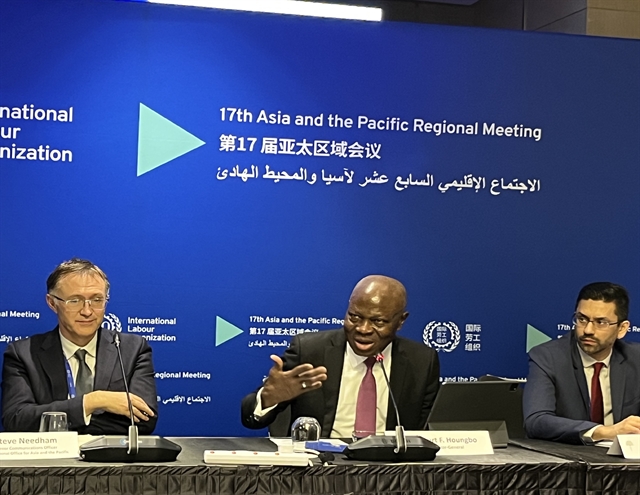 World
World

 |
| ILO Director-General Gilbert F. Houngbo (centre) speaks to the media on the sidelines of the 17th Asia and the Pacific Regional Meeting. VNS Photo Thu Hà |
Vũ Thu Hà
SINGAPORE – The Asia-Pacific region and the Arab states labour markets have partially rebounded from the impact of the COVID-19 pandemic, but the recovery has not been inclusive with underlying weaknesses remains to be solved, said ILO Director-General Gilbert F. Houngbo on Tuesday.
Houngbo was speaking to the media on the sidelines of the 17th Asia and the Pacific Regional Meeting, which gathers more than 500 ILO constituents representing governments, workers and employers from 33 countries across Asia, the Pacific and the Arab States.
“As we emerge from the pandemic, we see the region's resilience and dynamism," he said.
"Employment numbers have recovered, and jobs are returning as businesses are bouncing back. But still, we should acknowledge that the job growth scene has been mainly within the lower tiers of job quality.
“We can see that three in five workers still earn their incomes in the agriculture, retail and manufacturing sectors which remain characterised by limited labour productivity, low wages and poor working conditions.”
In the region which account for approximately 60 per cent of the world’s workforce, gender inequality remains rife in the labour market with women seeing hard won social and economic gains of recent decades eroded during the COVID 19 pandemic, according to the ILO chief.
He added: “During the COVID, a lot of women have left the job market, and the return is not necessarily at the same pace. So that can contribute to the global situation rolling back in terms of the economic women economic empowerment.”
At the same time, labour productivity has stagnated in the region' youth unemployment, with 15.5 per cent of young people unemployed in the Asia Pacific region, and almost 26 per cent in the Arab states.
According to a recent ILO’s report titled “The Asia–Pacific Employment and Social Outlook 2022: Rethinking sectoral strategies for a human-centred future of work”, employment numbers in the Asia Pacific region in 2022 were 2.0 per cent above the pre-crisis level of 2019, recovering from the loss of more than 57 million jobs in 2020.
By 2022, all subregions had regained the employment losses of 2020 and were showing positive employment growth over 2019. However, employment growth did not keep pace with population growth. Only in the Pacific was the employment-to-population ratio in 2022 above that of 2019.
The region still lacks 22 million jobs in 2022 and the figure is projected to increase to 26 million in 2023 given the headwinds to growth in the current geopolitical global and regional context.
Despite a good start in the beginning of this year, the recovery track began to slow from the third quarter, due to the multiple crises the world is facing, such as the war in Ukraine, economic slowdown, and high inflation, said the ILO head.
“It is estimated that 1.5 per cent of our work, which is equivalent to 40 million jobs, were lost in the third quarter of 2022.” Houngbo said, adding that this particularly hard hit the lower end of the labour market, which includes low-skilled and informal workers.
In order to leave no one behind, the ILO chief said multilateral and regional stake holders need to join forces and channel their efforts and resources in pursuit of a common goal of social justice.
He added: “With effective pro-employment policies, more social protection in respect of labour rights, consultative social dialogue and enabling business environments, countries can equip themselves to benefit from the future of work. The world also needs a proactive coalition that targets support towards the most vulnerable.” VNS




